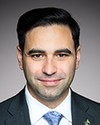Thank you very much, Mr. Chair.
Mr. Chair, ladies and gentlemen members of the committee, I am very pleased to be here with you today to talk about Canada's countries of focus for bilateral development assistance.
As the chair just said, my name is Deirdre Kent and I am the Director General of Development Policy at Global Affairs Canada. I am accompanied by my colleague Isabelle Bérard, Director General of the Americas Programming Bureau.
Today I will first explain the reasons why we choose certain countries for bilateral development assistance. Then we will discuss the measures taken to direct our assistance, as well as the sectors that benefit from it.
Before that, however, let me briefly explain the current context.
The Minister of International Development and La Francophonie, Ms. Bibeau, recently addressed the committee. As the minister explained to you, we have been conducting a review of our international development assistance policies and our funding framework. Our objective is to refocus Canada's international aid on the poorest and most vulnerable populations, and to support fragile states. This is one of the minister's main priorities. As Minister Bibeau stated, we must ensure that Canada's international aid responds to the needs of a new global context, which means that we must both overcome the obstacles and seize the opportunities.
We need to ensure that Canada's international assistance is aligned to support the new global development agenda, including the 2030 agenda for sustainable development, which has set the ambitious target of eradicating poverty globally in the next 15 years. This will require renewing Canada's approach and building on Canada's strengths and comparative advantages, including our existing relationships.
Canada has a tradition of broad global development, and advances its development priorities by working closely with a range of partners. As a result, Canada's international development and humanitarian assistance programming is delivered through multilateral organizations like the UN, Canadian and international civil society organizations, and public institutions in developing countries. Today, other actors—foundations, cultural community organizations, emerging donors, and private sector actors—are all growing in importance.
In terms of volume, roughly one-third of Global Affairs' international assistance in 2014-15 was bilateral—$1.25 billion out of $3.74 billion in total from Global Affairs. It is this bilateral funding that is subject to geographic focus.
Canada does retain a global reach through multilateral security and democratic development programming, and through our work with Canadian organizations and local developing country partners around the world. Furthermore, Canada's international humanitarian assistance is provided on a needs basis, guided by the humanitarian principles of humanity, neutrality, impartiality, and independence. It is not limited to specific countries or regions.
To be very clear, two-thirds of Global Affairs Canada's international assistance—multilateral funding, partnerships with civil society organizations and institutions, and our peace and security programming—is not subject to geographic focus. Therefore, my presentation today will focus specifically on bilateral development assistance.
Like other donor countries, Canada has strengthened the geographic focus of its bilateral assistance over the last 15 years in order to achieve greater results in reducing poverty. Geographic focus has been an important component of Canada's development effectiveness agenda.
The 2007 OECD Development Assistance Committee's peer review of Canada concluded that Canada was engaged in too many bilateral programs. They observed that this dispersed approach was limiting Canada's potential to achieve significant results. We were spread too thin. Our voice was diminished in countries where we were not a major donor, and our ability to have a measurable impact on the ground was limited.
By concentrating financial and human resources in fewer, larger bilateral programs, Canada has aimed to improve its ability to have a real impact through stronger relations and a more credible voice with local partners, including partner governments and other donors; and a better ability to respond to local needs and conditions, and align with local priorities in order to reduce poverty.
A focus on a limited number of countries is recognized as reducing the administrative burden on recipient countries through division of labour among a few larger donors. It has helped Canada to reduce administrative overhead, as fewer transactions are required, delivering more aid per dollar spent.
Focus also helps to position Canada among the major donors in a country, providing greater influence and an ability to program in a wider range of sectors to increase our field presence and to have more active in-country engagement. In addition, developing countries have identified focus as important for aid predictability and transparency where commitments over time are required for sustainable development results.
How do we focus?
Canada's bilateral development programming greatly increased its focus from 2000 to 2015, moving from 89 to 37 bilateral country programs. Canada currently has 25 countries of focus and 12 partner countries for its bilateral development assistance. In June 2014, Canada increased the number of countries of focus for Canada's bilateral development assistance from 20 to 25.
The 25 countries were chosen based on their needs, namely the extent of poverty, vulnerability, and underdevelopment in the country; their capacity to benefit from development assistance, and the potential for aid to translate into concrete results; and their alignment with Canadian policy priorities. These same criteria were also used in 2008-09 to make decisions based on Canada's initial list of 20 countries of focus.
Canada increased the number of countries of focus in 2014 due to an increased emphasis on bilateral programming, and 90% of bilateral development assistance spending takes place in countries of focus compared to 80% previously. The remaining bilateral spending is primarily in Canada's 12 development partner countries formally called countries of modest presence, as well as a small number of regional programs, such as the pan-Africa regional program.
Our bilateral programming is targeted toward the priorities of our partner countries and is in line with five thematic priorities for international assistance, namely, increasing food security, stimulating sustainable economic growth, securing the future of children and youth, advancing democracy, and promoting stability and security.
Canada's bilateral development assistance involves broad global engagement in Africa, the Americas, Asia, Eastern Europe, and the Middle East. Thirteen of Canada's 25 countries of focus are least developed countries where poverty rates are highest, but we are also working in lower-middle income countries, some of which are fragile states where important pockets of poverty remain. Africa is the most important region with 10 countries of focus.
There are a range of approaches used internationally for determining geographic focus. As part of the evidence base for our international assistance review, we are looking to learn from other donor countries. Some donors, such as the Netherlands, Sweden, and France, use a tiered approach based on country type or income group. The focus of their cooperation differs by group. For example, they may focus on stabilization and peace building in fragile states, on economic growth, or on triangular cooperation with middle-income countries.
Some donors such as Australia have a geographic focus on their immediate region. The United Kingdom devotes a set proportion of 50% of its bilateral assistance to fragile states.
In conclusion, one of the central objectives of the international assistance review is to refocus Canada's aid in order to support the poorest and most vulnerable populations, as well as fragile states. The study will among other things look at the best way to refocus efforts on the poorest and most vulnerable, as well as ways of improving our effectiveness and bolstering innovation.
This gives us an opportunity to reassess our current approaches in light of the information we collect, especially through consultations. We look forward to hearing your committee comments in the context of the information-gathering aspect of our review.
Ms. Bérard and I will be happy to answer your questions.
Thank you.




